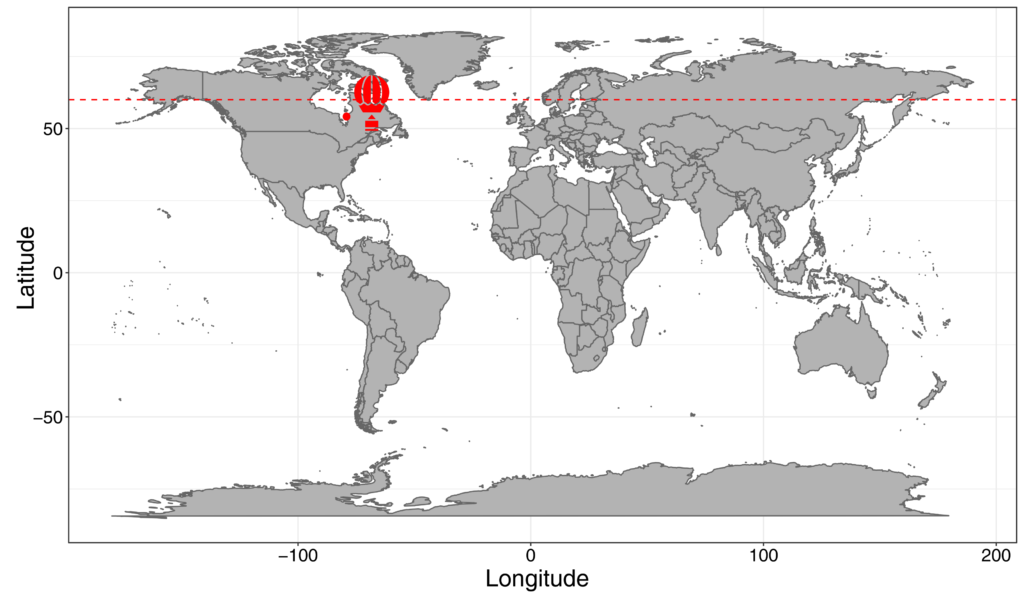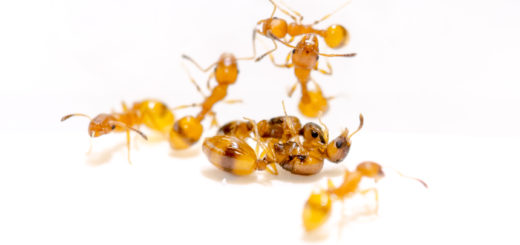The Latitude Project – 60° North – Canada

Javier Ibarra-Isassi 
Jean-Philippe Lessard
Myrmecological News Blog has launched The Latitude Project – by using latitudes to circle the globe, we collect impressions of the ants of the world in terms of their diversity, ecology, life history, and conservation biology. Starting with 60° North, we shine flashlights on the ants of every continent passed by interviewing ant researchers on every continent. Our second interview is with Javier Ibarra-Isassi and Jean-Philippe Lessard in Canada, North America (following that with Riitta Savolainen in Finland, Europe).
An Interview compiled by Florian M. Steiner

MNB: What are your GPS coordinates?
JI-I & J-PL: Our lab is located in the Loyola Campus of Concordia University in Montreal, Quebec, Canada. The GPS coordinates are 45.4576° Latitude and -73.6413° Longitude. However, some of our field work with ants takes place at 53.7109° Latitude (Radisson, Quebec).
It is worth noting that approximately 85% of the population in Canada is concentrated in the cities near the Canada-US border (between 42° and 49° Latitude). The rest of the territory is sparsely inhabited by indigenous populations. As a point of reference, three of the most northern provinces: Northwest Territories, Nunavut and Yukon account for a third of land area but less than 1% of the national population (2016 Census, Statistics Canada). This makes scientific research in northern latitudes a logistical challenge. In the province of Quebec, for example, there are very few research stations past the 49th parallel, and sampling can prove logistically and financially difficult beyond this point.
MNB: What are the annual mean temperature and the annual precipitation in your area?
JI-I & J-PL: Annual Mean Temperature in Radisson, Quebec: -3.6 °C; Annual Precipitation in Radisson, Quebec: 672 mm.
MNB: Which ant subfamilies occur there?
JI-I & J-PL: Formicinae, Myrmicinae, Dolichoderinae.
MNB: What is a typical natural habitat in your area?
JI-I & J-PL: A typical habitat around Radisson, Quebec is mostly dominated by conifers such as black spruce trees (Picea mariana), white spruce (Picea glauca), jack pine (Pinus banksiana), balsam fir (Abies balsamea) and tamarack or American larch (Larix laricina). Some broadleaves such as white birch (Betula papyrifera), trembling aspen (Populus termuloides) can also be found scattered in between coniferous trees. Lichen covers the sandy soil in the forest, and sphagnum moss is abundant in wetlands.

MNB: How many ant species typically occur in this habitat?
JI-I & J-PL: We have sampled a total of nine ant species in the Radisson area: Myrmica alaskensis, Myrmica cf. fractictornis, Leptothorax muscorum, Leptothorax acervorum, Tapinoma sessile, Camponotus herculeanus, Formica neorufibarbis, Formica podzolica and Formica aserva. However, this number is reduced to six near the latitudinal tree line (Francoeur 1983) and to five beyond it (Francoeur 2001).
MNB: What is your favourite ant from your area, and what fascinates you most about it?
JI-I & J-PL: Our favourite ant is Formica neorufibarbis. One fascinating aspect of this species is its broad distribution in North America (from New Mexico to Northern Canada). In our own samples from Quebec, we have found it between 46° and 59° Latitude. We have found that southern colonies tend to have larger, lighter-coloured workers, with a more reddish mesosoma. In contrast, the mesosoma of more northern colonies has a darker shade of brown and are somewhat smaller.
In a recent visit to the wetlands around the 48° parallel, we encountered a colony that had two distinct worker morphs: a smaller concoloured dark-brown morph and a bicoloured dark-brown/red morph. This was first reported by Bernstein (1976) as a potential adaptation to colder environments. She suggested that the small dark workers heat up faster in the mornings to allow them to forage in low temperatures. Additionally, the colony we found was polygynous, pointing at the phenotypic plasticity of this intriguing species. This and other traits allow F. neorufibarbis to occur in different environments, in open and semi-closed habitats and even wetlands.


MNB: Where does your favourite ant species nest, and how many workers live in one nest, roughly?
JI-I & J-PL: We have been able to find F. neorufibarbis mounds in the soil, in open habitats and semi-closed forests and even forming needle mounds in the wetlands. In forests, we have found them under rocks and partially in rotten wood, with most of the nest found in the soil. In the wetlands, we have found mounds made from organic matter, mostly from dried sphagnum moss and spruce needles.
Most colonies we sampled were small, monogynous colonies with around 40 workers, with one colony having around 120 workers. However, we have observed larger colonies, with hundreds of workers ready to defend their nest when disturbed. Previous work showed that less than 5% of sampled F. neorufibarbis nests (n=184) exceed 300 workers in the alpine tundra (Billick 1999), indicating that it would be uncommon to find large colonies (>300 workers) in the northern boreal forest of Quebec.
MNB: Do you know its mating strategy, how new nests are founded, and how many queens are in one nest?
JI-I & J-PL: We believe the nuptial flight occurs late in the summer because we have found alates present in late July and early August. Since queens have wings, we believe these ants follow the “male-aggregation” pattern in which queens and males mate far away from the mother colony. However, there are no records of these events in our region.
We found most of our sampled colonies in the Taiga with a single queen in early July, suggesting that individual queens found colonies before the first frosts and overwinter alone or soon after the snow melts. In contrast, Francoeur (1973) mentions that colonies in the arctic tundra are polygynous and have smaller queens, similar to what has been reported to colonies found in the alpine tundra (Billick 1997). This suggests potential variation in these traits along the latitudinal gradient, opening an interesting avenue for a future research topic.
MNB: What do workers feed on? What do they feed to larvae?
JI-I & J-PL: We have observed F. neorufibarbis workers mostly carrying dead arthropods and feeding on root-aphid honeydew, but we believe it feeds on whatever food is available as well (e.g. flower nectar, pollen). We do not know what they feed to larvae, but given its relatively short rearing time, we think they feed honeydew to larvae.
MNB: Is the species territorial, and if so, how does it defend its territory?
JI-I & J-PL: Usually, when we find a forager, it trusts on how well it blends with its environment, standing still until our forceps or aspirator comes nearby. This made us think that this species is timid, but we have witnessed some degree of aggressiveness towards intruders. We have seen Formica neorufibarbis colonies raided by slave-making ants in the area (i.e. Formica aserva), and at first it defended its colony successfully, but it quickly got outnumbered. On the other hand, we noticed that it ignores other smaller ants in the area (e.g. Leptothorax muscorum, Myrmica alaskensis), even when attracted to the same bait.
On the human side, it has a nasty bite that we can feel every time we are digging up a nest. Moreover, it can spray formic acid, making collecting them with an aspirator a throat-burning task if not done properly.
MNB: How common is your favourite ant, and is it threatened?
JI-I & J-PL: Formica neorufibarbis is commonly found and easy to recognize in the Taiga and Tundra habitats. This species can tolerate a broad range of canopy coverage, requiring only that humidity levels stay relatively high in the environment.
We do not know for certain how this species responds to the fire dynamics of the boreal forest, but the traits (e.g. large workers, behavioural dominance, worker size and colour variation) of this species would suggest that it would quickly dominate recently burned habitats.
References
Bernstein, R. 1976: The adaptive value of polymorphism in an alpine ant, Formica neorufibarbis gelida Wheeler. – Psyche: A Journal of Entomology 83:180-184.
Billick I. 1997: Growth, reproduction, and worker polymorphism of the ant species Formica neorufibarbis Wheeler. – Ph.D. dissertation, The University of California, San Diego, CA.
Billick I. 1999: The use of mark-recapture to measure worker number in the rock nesting ant species, Formica neorufibarbis Emery. – Insectes Sociaux 46: 256-260.
Francoeur, A. 1973: Révision taxonomique des espèces néarctiques du groupe fusca, genre Formica (Formicidae, Hymenoptera). – Mémoires de la Société entomologique du Québec 3: 1-316.
Francoeur, A. 1983: The ant fauna near the tree-line in northern Quebec (Formicidae, Hymenoptera). – Collection Nordicana 47: 177-180.
Francoeur, A. 2001: Les fourmis de la forêt boréale du Québec. – Le Naturaliste Canadien 125: 108-114.








Since I am much interested in this project I feel compelled to question the occurrence of Leptothorax muscorum (Nylander, 1846) in that area.
The species has been described from Finland, and it is widespread in temperate and boreal Eurasia, but all records from North America are at least dubious (see map in https://antwiki.org/wiki/Leptothorax_muscorum ). Having collected Leptothorax species in many parts of NA, together with A. Francoeur, R. Stuart, T. M. Alloway, J. Heinze and K. Fischer, we never found a species that was clearly L. muscorum. There are several quite distinct species instead.
In his revision, W. L. Brown jr. in 1955 ( https://antwiki.org/wiki/images/0/0c/Brown_1955a.pdf ) had synonymized all known forms with L. muscorum because of lack of outstanding hairs on scapes and tibiae (in contrast to L. acervorum). We have been as far north as Chibougameau (49.9°N) and Magpie (50.3°N), and have collected up to there a species with queen polymorphism (alate vs. intermorphic to ergatomorphic female reproductives), that I first detected near Tadoussac. This species apparently is undescribed as yet; it is provisionally named „Leptothorax sp. A“, e.g. in https://www.antwiki.org/wiki/images/4/46/Heinze_J_1987.pdf , or in https://www.antwiki.org/wiki/images/e/ec/Loiselle_et_al_1990.pdf
Also A. Francoeur (2001) mentions this species as Leptothorax sp. A.
http://entomofaune.qc.ca/entomofaune/fourmis/Fourmis-Publications/Fourmisboreales.Quebec.pdf )
Anyhow, I wonder which „form“ you have identified as L. muscorum. 😉
Regards, A. Buschinger